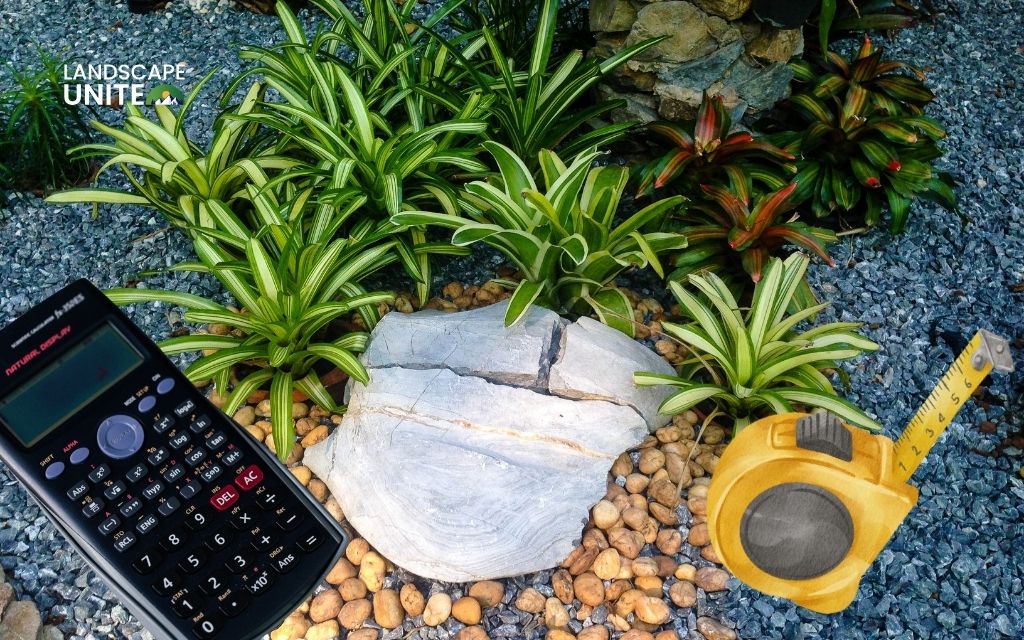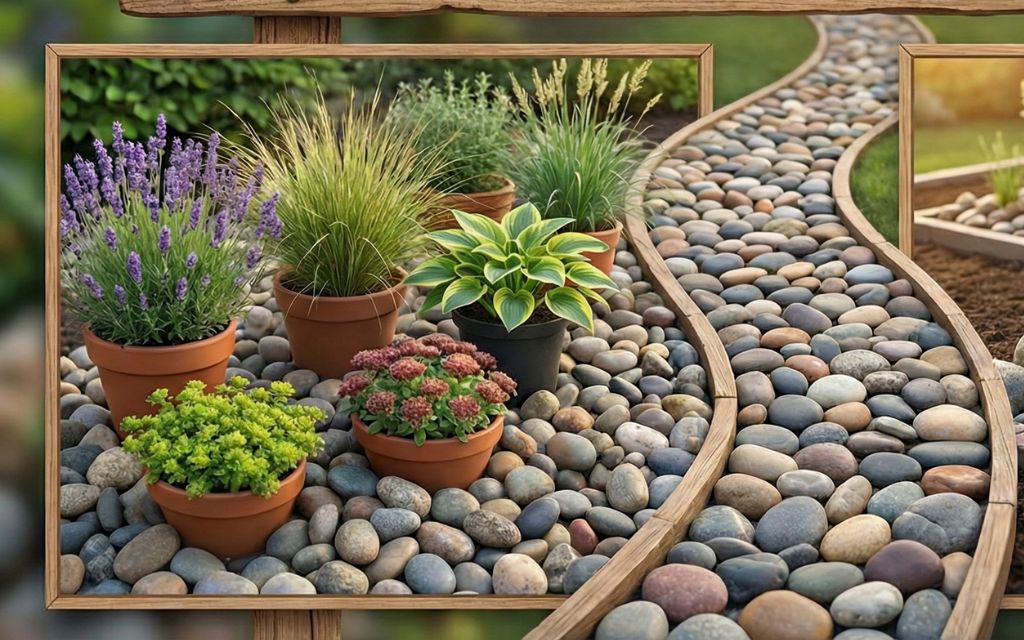Every dog owner faces the same challenge: creating an outdoor space where your furry friend can play safely while keeping water bills reasonable. A dog-friendly xeriscape backyard combines water-wise landscaping with pet-safe elements that work across diverse U.S. climates.
Whether you’re dealing with Arizona heat or unpredictable weather, water-wise landscaping for dogs offers practical solutions that benefit both your pet and your wallet. This article provides real ideas, plant suggestions, and layout landscaping tips that work nationwide.

What makes a xeriscape backyard dog-friendly?
A successful dog friendly xeriscape backyard balances water conservation with your pet’s comfort and safety.
Here are the essential elements your dog needs to thrive:
- Cool, paw-safe surfaces: Your dog’s paw pads are sensitive to heat. Materials like decomposed granite or flagstone stay cooler than dark concrete or asphalt. Avoid surfaces that absorb and retain heat, which can burn paws during the summer months.
- Shade and easy-to-clean zones: Install shade structures like pergolas or plant native trees for natural cooling. Choose hardscape materials that rinse clean easily, making waste cleanup and odor control simple.
- Space for natural behaviors: Dogs need areas where they can sniff, dig (in designated spots), roll, and play. Mix different textures to keep your dog mentally stimulated.
- Safety from toxic plants and hazards: Many drought-tolerant plants are toxic to dogs. Always research plant safety before adding to your yard. Avoid sharp rocks, cactus with spines, or materials that could injure paws.
3 Key elements of a dog-friendly xeriscape design
Building a successful dog friendly xeriscape backyard starts with understanding 3 components:
- Hardscaping materials that won’t burn paws
- Plants that are both drought-tolerant and safe for pets
- Ground covers that can withstand enthusiastic play.
Let’s explore each element in detail.
Pet-safe hardscaping materials
Your choice of hardscaping materials can make or break your dog friendly xeriscape backyard. The right surfaces stay cool enough for sensitive paw pads, drain well to prevent muddy messes, and stand up to daily wear from active pets.
- Use decomposed granite, flagstone, or pea gravel for paths and open areas. These materials stay relatively cool, drain well, and provide comfortable surfaces for dogs to walk on.
- Avoid heat-absorbing surfaces like dark concrete or rubber mulch. These materials can become dangerously hot during summer and potentially burn your dog’s paws.
- Consider shaded patios or pavers that stay cool for sensitive paws. Light-colored pavers under pergolas or shade structures create comfortable resting spots during hot weather. For more comfort, place these cool zones strategically where your dogs naturally tend to rest during the day.
Drought-tolerant, dog-safe plants
Choose non-toxic native species that need little water and won’t irritate your pet’s skin. Native plants are naturally adapted to your region’s climate, requiring less supplemental watering once established. They also support local ecosystems and pollinators.
Here are excellent options for various U.S. regions:
- Blue Fescue: An ornamental grass with silvery-blue foliage that adds texture and requires minimal water. Safe for dogs and deer-resistant.
- Blue Grama Grass: Native prairie grass, extremely drought-tolerant, perfect for naturalized areas
- Yarrow: Produces clusters of flat-topped flowers in white, yellow, or pink. Extremely drought-tolerant once established and non-toxic to pets.
- California Lilac: A Western native with fragrant blue or white flowers. Requires very little water after the first year and attracts beneficial pollinators.
- Lavender: Aromatic, drought-loving herb that dogs typically avoid due to its strong scent. Can help repel fleas naturally.
- Catmint: Lavender-blue flowers, attracts pollinators, drought-resistant and safe for dogs
- Rosemary: Another fragrant herb that thrives in dry conditions. Safe for dogs and can double as a culinary herb for your kitchen.
- Desert Marigold: A Southwest native with cheerful yellow flowers that blooms much of the year with minimal water.
- Red Yucca: Coral-red flower spikes, not a true yucca (soft leaves, no dangerous spines), very low water requirements.
- Desert Marigold: Bright yellow flowers, minimal water needs
Avoid toxic plants like oleander, foxglove, and sago palm. These common xeriscape plants are dangerous to dogs, causing symptoms ranging from digestive upset to organ failure. Always research any plant before adding it to your dog-friendly xeriscape backyard. Other plants to avoid include azaleas, castor bean, autumn crocus, and yew.
Find out more about the best xerophytes for landscaping that you can easily apply in your yard.
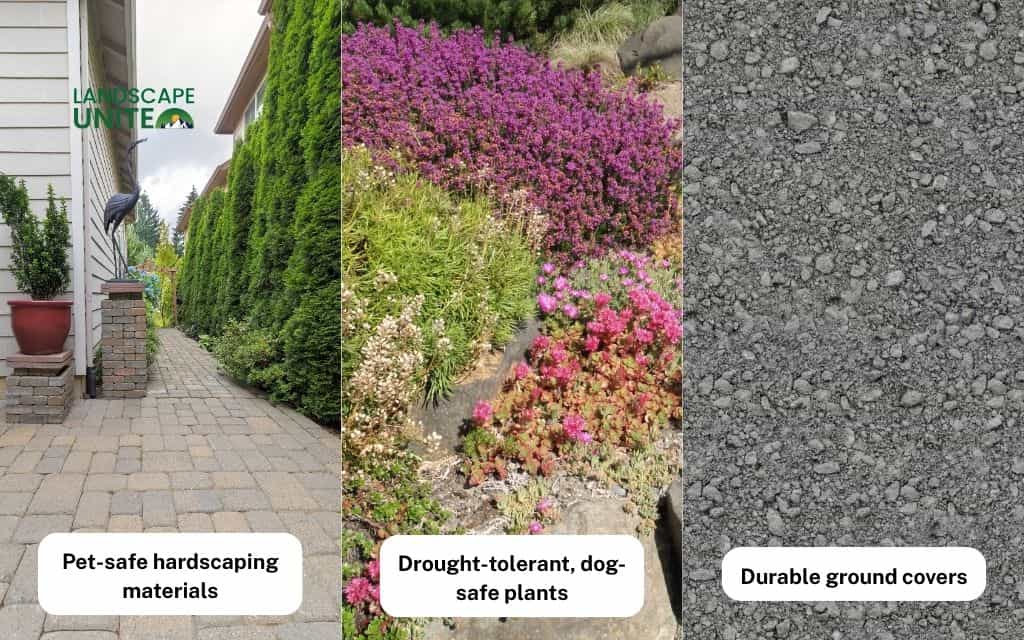
Durable ground covers
Traditional thirsty turfgrass has no place in a water-wise landscape, but that doesn’t mean your dog-friendly xeriscape backyard needs to be all rocks and hardscape.
Drought-tolerant ground covers provide soft surfaces for play while using a fraction of the water.
Replace traditional grass with hardy, water-smart alternatives:
- Buffalo Grass (native, low water use): Uses up to 75% less water than traditional turf, tolerates moderate dog traffic, and works well in Great Plains, Southwest, and Southern regions.
- Clover (soft on paws and resilient): Stays green with minimal water, gentle on paws, and naturally enriches soil. White clover or microclover varieties are ideal for dog areas.
- Kurapia or creeping thyme (fragrant and low-growing): Release pleasant scents when stepped on, form dense mats that resist dog traffic, and require minimal water once established.
These handle light digging and dog traffic better than turfgrass, recovering quickly from disturbance while eliminating the need for frequent mowing.
10 dog-friendly xeriscape backyard ideas for homes across the U.S.
1. Dog-friendly mulch paths with shady shrubs
Transform walkways using shredded bark or cedar mulch that feels soft under paws while staying cooler than hardscape. Plant low-water shrubs like fernbush or rabbitbrush alongside paths for natural shade. Add stepping stones for human access while keeping the soft surface for dogs. This pet friendly water wise garden approach reduces water usage by 60% compared to traditional lawn paths.
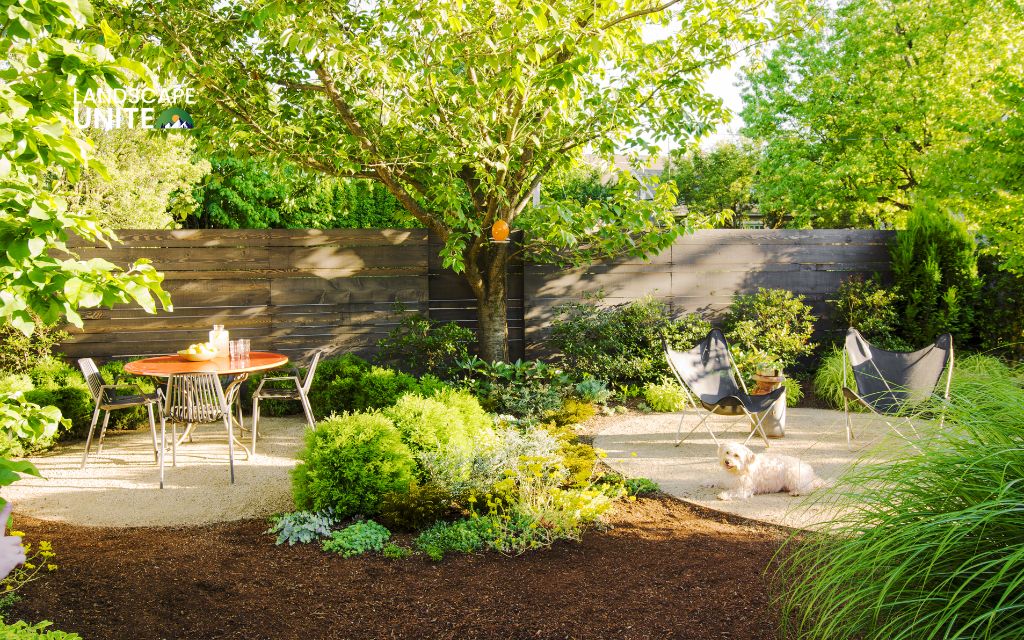
2. Designated dig zone with gravel or sand pit
Channel your dog’s digging instincts by creating a dedicated area in one yard corner – line with decomposed granite, sand, or mulch to contain mess while satisfying natural behaviors. Bury dog-safe toys occasionally to encourage use. This dog-friendly desert backyard landscaping idea on a budget technique requires minimal materials while protecting expensive plantings.
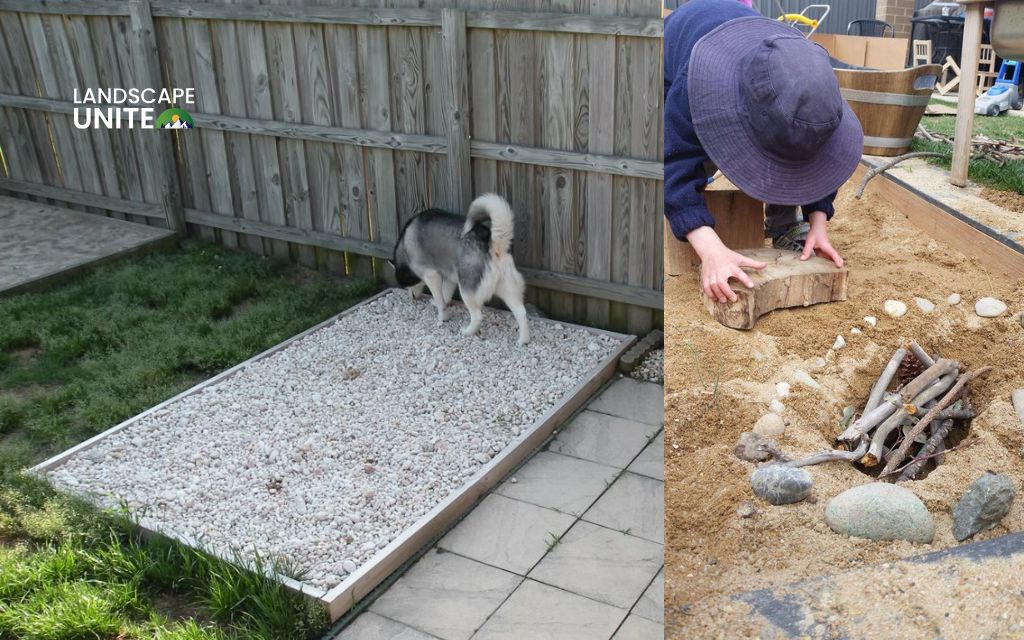
3. Paw-friendly grass alternatives
Replace water-hungry lawns with UC Verde Buffalo Grass, RTF Fescue, or clover-turf blends that handle traffic while requiring 50% less water. These alternatives feel cooler under paws and provide natural texture dogs love. Frame with gravel borders to prevent edge wear from heavy traffic.
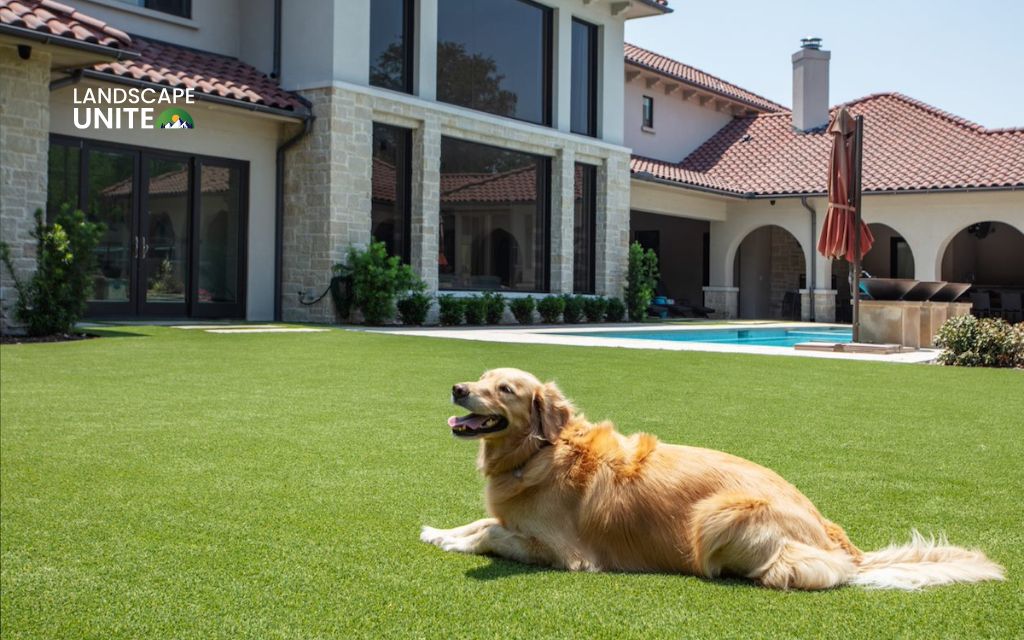
4. Boulder playground with native groundcovers
Install smooth granite or sandstone boulders with rounded edges for climbing and exploration. Surround with creeping thyme, ice plant, or sedum groundcovers that tolerate foot traffic. This xeriscaping ideas that won’t hurt dogs feet design satisfies dogs’ desire for elevation changes while creating an attractive focal point.
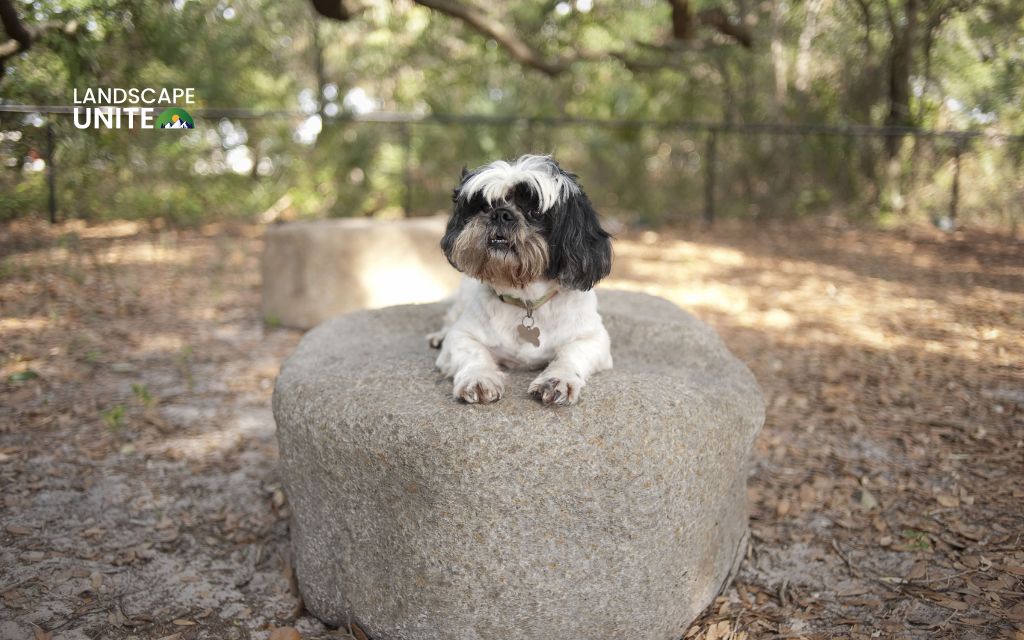
5. Compact low-water lawn patch for play
Maintain a small turf area (400-800 sq ft) for activities like fetch. Use turf-type tall fescue or hybrid bluegrass for durability. Frame with gravel paths and install drip irrigation to minimize water waste while ensuring adequate moisture for heavy-use areas.
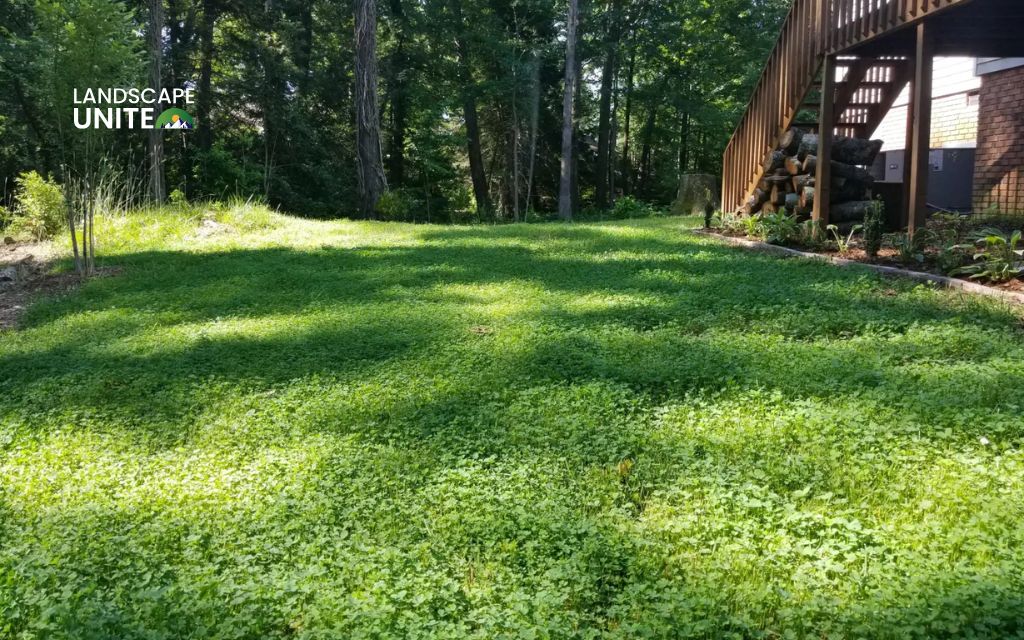
6. Shade canopy area with cooling features
Create refuge using pergolas or shade sails over decomposed granite surfaces. These structures reduce ground temperatures by 10-15°F. Add cooling mats, elevated beds, and water stations. This approach uses specialized ground materials with stabilized earth technology that stays cooler than traditional pavers.
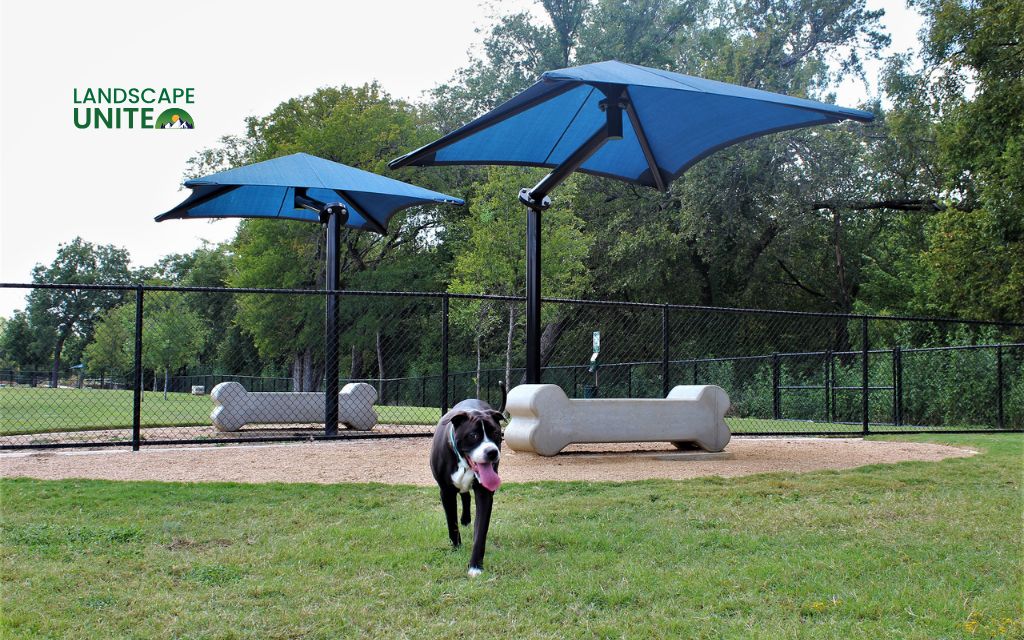
7. Dog-accessible raised beds with buffers
Elevate planting areas 12-18 inches to prevent digging while creating clear boundaries. Leave 1.5-2 foot buffer paths between beds and dog areas. Use drought-tolerant native flowers or herbs in protected zones.
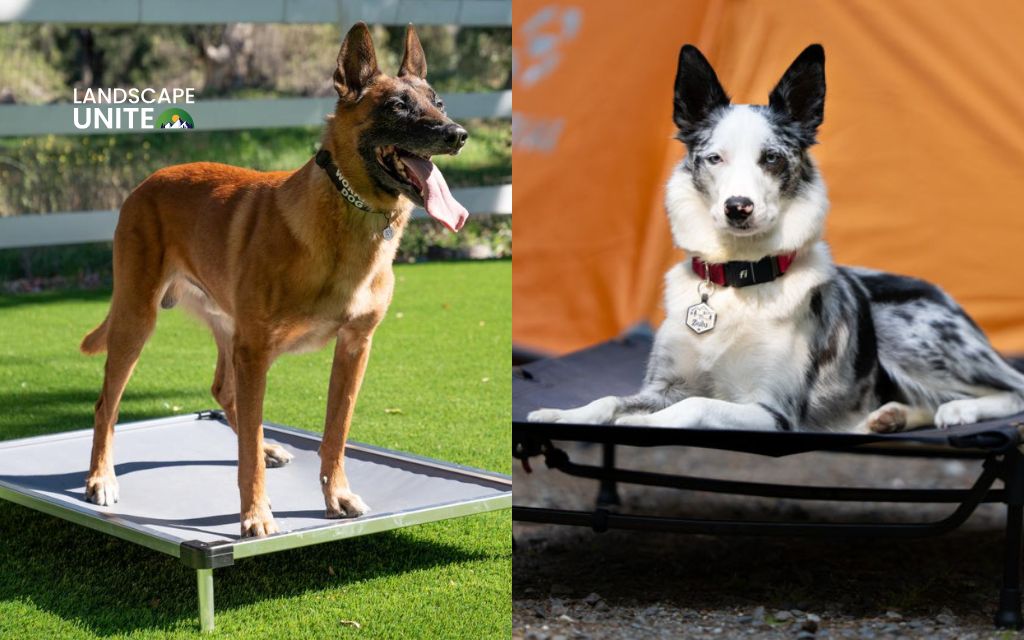
8. Privacy border with drought-tolerant shrubs
Plant water-wise shrubs like sand cherry, sumac, or serviceberry along property lines. Position 3-4 feet from fences to prevent jumping while maintaining privacy screens. These non toxic xerophytic plants for dogs southwestern US serve dual landscape and wildlife exclusion purposes.
Find out more about the dry-tolerant plants collection in this guide.
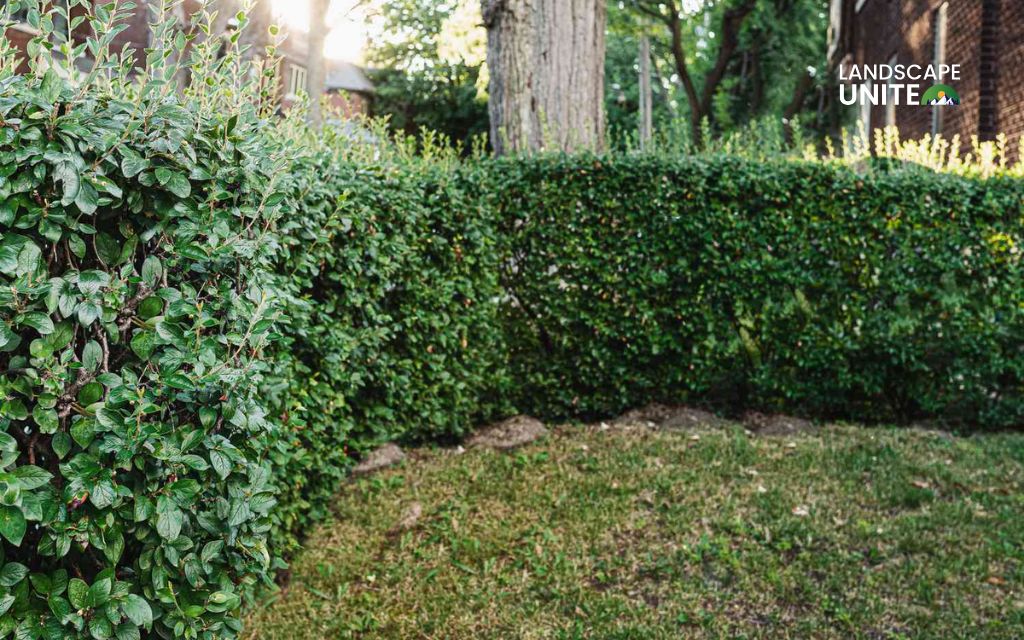
9. Self-draining potty corner
Designate a shaded corner using pea gravel with slight drainage slope. This functional area simplifies cleanup while containing odors. Install optional neutralizer stations for easy maintenance while preventing standing water.
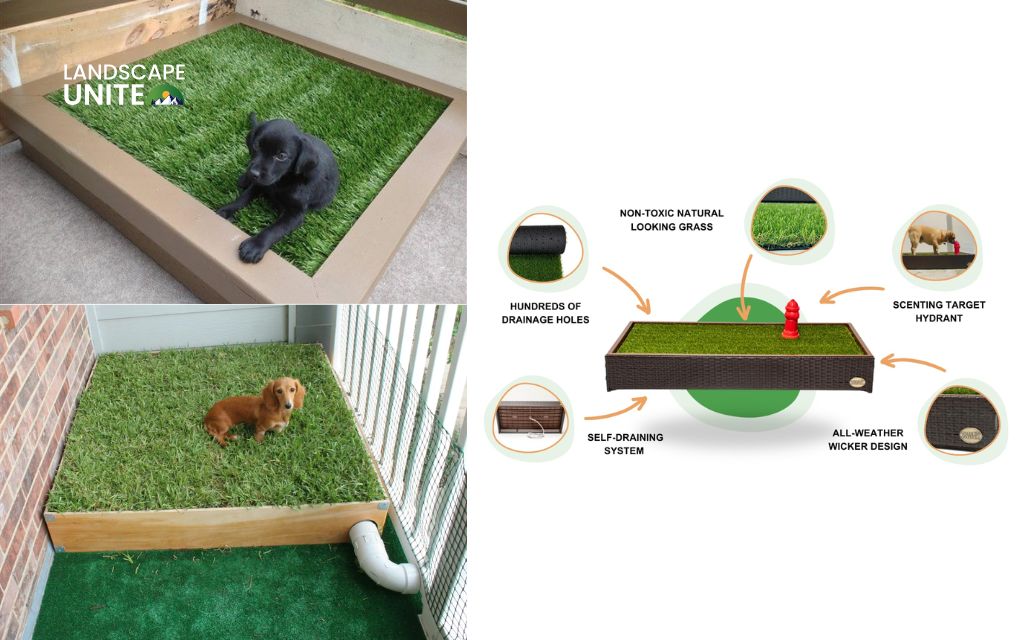
10. Flagstone patio with native plant edging
Create gathering spaces using natural stone that stays cool compared to concrete. Edge with blue mist spirea, yarrow, or prairie zinnia. These pet safe xeriscape plants for hot climates add visual appeal without compromising safety while requiring no irrigation.
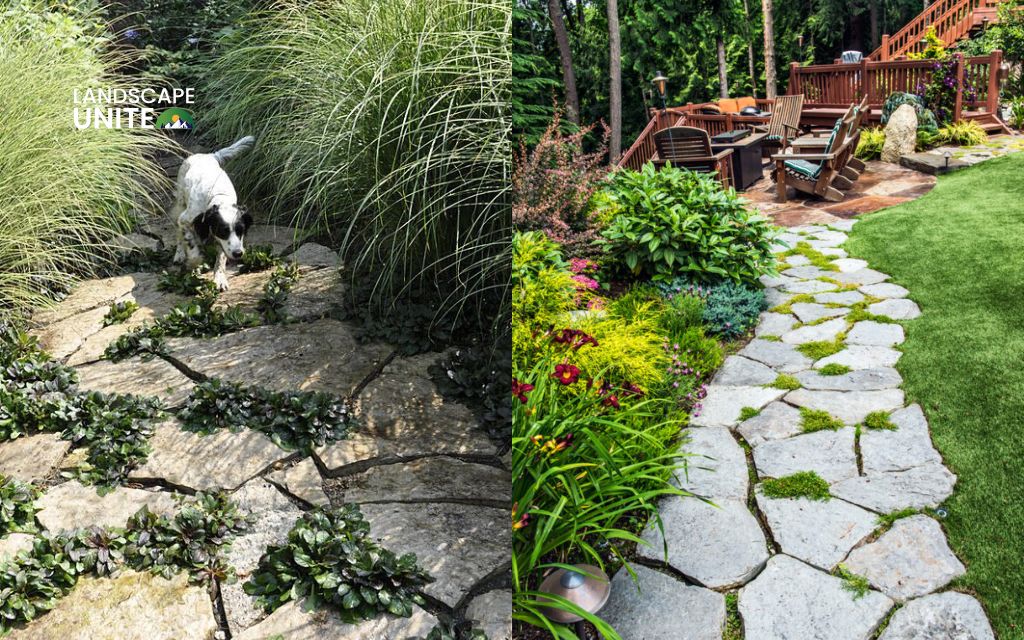
How to xeriscape with safe materials for dogs
Material selection directly impacts your dog’s comfort and safety in xeriscaped environments. How to xeriscape your yard successfully requires understanding which surfaces work best for pet areas.
Recommended ground surfaces:
- Cedar or shredded bark mulch (avoid cocoa mulch which contains toxic theobromine)
- Pea gravel and decomposed granite for drainage and cooling
- Artificial turf with cooling layers or adequate shade coverage
- Flagstone and natural stone with rounded edges
- Permeable pavers that allow water infiltration
Materials to avoid:
- Sharp-edged rocks or crushed glass
- Rubber mulch that retains heat and may contain toxic compounds
- Cocoa hull mulch which is toxic to dogs
- Non-draining hardscape that creates standing water
- Metal surfaces that become extremely hot
How to xeriscape with rocks effectively means choosing smooth river rock or rounded gravel rather than sharp angular materials. Size matters too – select pieces large enough that dogs won’t swallow them accidentally. Use permeable materials whenever possible to manage runoff in areas with heavy rainfall or clay-based soils. This approach prevents puddling while maintaining the water-conservation benefits of xeriscaping.
Design tips for multi-dog or high-activity yards
Managing multiple dogs or highly active pets requires strategic planning to ensure your dog friendly xeriscape backyard can handle increased wear and usage patterns.
- Zone division strategy works best for busy yards. Create distinct areas for running and playing, shade and rest, potty needs, and garden viewing. This separation prevents overuse of any single area while meeting diverse needs.
- Install clear pathway systems using crush-proof surfaces like gravel or decomposed granite that handle heavy foot traffic without creating mud or bare spots. Wide paths accommodate dogs running side by side.
- Use strategic edging to define boundaries around sensitive plantings or areas where you need to restrict access. Low decorative fencing or raised beds create visual barriers without completely blocking sightlines.
- Consider elevation changes through berms, terracing, or raised areas that add interest while creating natural boundaries. Dogs enjoy varied topography for exploration and viewing different areas of the yard.
- Plan for seasonal adaptations by incorporating removable elements that adjust to weather extremes while maintaining functionality year-round.
Maintenance tips for dog-friendly xeriscape yards
A dog friendly xeriscape backyard requires minimal maintenance, but regular care keeps the space safe and functional.
- Inspect for hot surfaces in summer and provide paw-safe routes. Test hard-scape surfaces with your bare feet during hot weather. If it’s too hot for you, it’s too hot for your dog. Add shade or create alternative cool pathways as needed.
- Refresh mulch or decomposed granite every 1-2 years. Add a fresh 1-2 inch layer to maintain drainage, prevent weeds, and keep the yard looking fresh. This simple task takes just a few hours annually.
- Trim plants to prevent overgrowth near walkways. Prune back growth that encroaches on dog paths. Regular light trimming keeps pathways clear and encourages healthier, bushier plant growth.
- Rinse hardscaped areas to control odors. Hose down decomposed granite, flagstone, or patio areas regularly to eliminate pet odors. Use pet-safe enzymatic cleaners for stubborn odor problems in high-traffic relief areas.
Maintain drip systems to ensure efficiency. Check monthly for clogged emitters, damaged lines, or leaks. Flush the system seasonally and adjust watering schedules as plant needs change. Proper maintenance ensures years of efficient water use.
Conclusion
Your dog deserves an outdoor space that satisfies their natural instincts while respecting water conservation needs and your budget. A thoughtfully designed dog friendly xeriscape backyard provides the perfect solution, combining practical pet areas with beautiful, drought-tolerant landscaping.
From designated dig zones to cooling shade areas, every element serves both water conservation and pet comfort goals. The plant and material recommendations in this guide help you create safe, engaging outdoor environments that work across diverse U.S. climates.
Ready to transform your backyard into a water-smart pet paradise with the landscaping expertise? Subscribe to the Landscape Unite blog for more expert tips on creating beautiful, functional outdoor spaces. Discover new posts covering everything from seasonal maintenance to advanced design techniques that make your landscape both stunning and sustainable.
FAQs about dog friendly xeriscape backyard
Can you xeriscape your yard with dogs?
Yes, xeriscaping for dogs works excellently when you plan for their needs. Dogs actually thrive in well-designed water-wise landscapes that provide cool surfaces, shade, and safe exploration areas. The key is choosing appropriate materials and plants while creating designated zones for different activities.
What is the best drought-tolerant ground cover for dogs?
Clover ranks as the top choice for pet friendly water wise garden applications. It stays green with minimal water, tolerates foot traffic, and provides soft texture dogs love. Creeping thyme offers another excellent option with aromatic foliage and tiny flowers that attract beneficial insects.
What is a good alternative to grass for dogs?
Finely shredded cedar mulch works wonderfully for play areas, staying cooler than artificial alternatives while providing natural cushioning. Decomposed granite offers durability for high-traffic zones, while artificial turf provides consistent texture year-round with proper shade coverage.
Are xeriscape plants toxic to dogs?
Some traditional xeriscaping plants can be harmful to pets, making research essential. Always consult the ASPCA’s plant database and your veterinarian before selecting plants. Many safe options exist, including yarrow, purple coneflower, and blue grama grass that provide beauty without compromising pet safety.
How much water does a dog-friendly xeriscape save?
Well-designed dog friendly xeriscape backyard installations typically reduce outdoor water usage by 50-75% compared to traditional lawn landscapes. The exact savings depend on your climate, soil conditions, and design choices, but most homeowners see significant reductions in irrigation costs within the first growing season.
